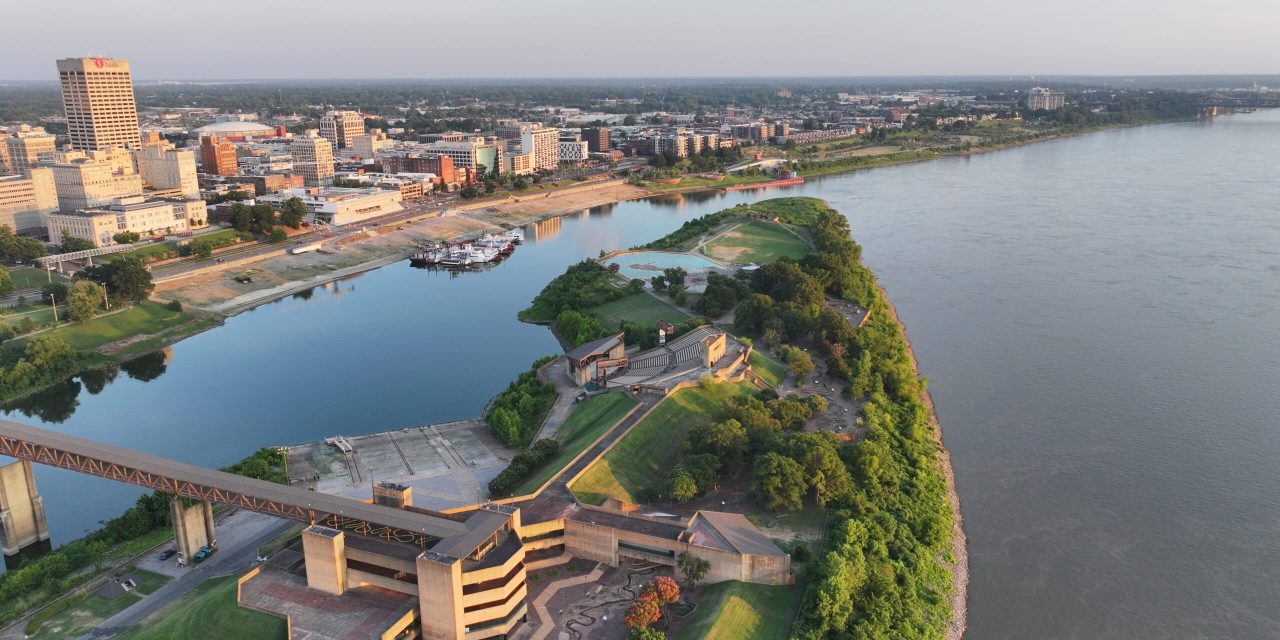The following is my October City Journal column in Memphis magazine:
Mud Island Park has been called many things, but most of all, it should be called a cautionary tale.
Opened to a gala celebration on the Fourth of July, 1982, its 52 acres have confounded city officials for decades with a history equal parts nostalgic and troubled.
There are many lessons to be learned from its 43 years. There are lessons about overly optimistic financial and attendance projections, about overpromising impact, about emphasizing tourists over residents, and about failing to fund upkeep. It’s become a place where ideas go to die — a major freshwater aquarium, a zip line, luxury glamping, a pedestrian bridge on the south end, and an extension of Bass Pro Shops.
Nostalgia flows from memories of concerts at the amphitheater on special nights with the panoramic city skyline as dramatic backdrop. However, under the weight of changing markets and technology, it is today outdated and according to some promoters, even misplaced.
Then, there are memories of family visits centered on the lure of splashing water in the detailed 2,000-foot scale model of the Lower Mississippi Valley. Pressure washing burnished its appearance but it still has plaques with missing information.
There was also the entertaining mile-long ride on the monorail to Mud Island that promised the special experiences ahead. Featured in the 1993 film, The Firm starring Tom Cruise, it projected an image of a modern and innovative city but was shut down seven years ago when parts were no longer available for its 1960s suspension railway technology.
Nostalgia overshadows an inconvenient fact: the park was considered a problem by city government almost from the beginning. Within seven years of its opening, it was called a “white elephant” by City Council because it was not producing enough revenues to cover its operating costs.
Only seven years after it opened, Mayor Dick Hackett, looking for a way to remove the cumulative $12.5 million in operational losses from the city’s books, turned to Sidney Shlenker to manage Mud Island after he claimed he would raise $110 million to create a theme park there called Rakapolis, a mixture of Memphis music and Egyptian mysticism that was to include the Pyramid. By 1991, he was bankrupt, he left Memphis in disgrace, and his last name became a verb for fraudster.
In 2000, City of Memphis turned over operations for riverfront parks, including Mud Island, to newly created Riverfront Development Corporation, which in 2018 gave way to Memphis River Parks Partnership which supplemented its budget with private donations. City government remained responsible for capital funding but over four decades, there was no regular capital funding to keep the park current and well-maintained. It became a testament to what happens when city government builds a $62 million project – $208 million in today’s money – and thinks its job is done.
Finally, three years ago, Memphis City Council approved $10 million in capital funding for Mud Island improvements but took $5 million back and spent it on other city projects. About the same time, city government put $17.6 million in its capital improvement budget for improvements to the amphitheater after vocal advocates demanded its renovation. The money is slated for 2027-2029. City officials said the outdated facility has safety risks and liability concerns but they continue to talk with the Downtown Neighborhood Association about its idea for popup concerts.
Frustration about the slow pace of redevelopment on Mud Island routinely is more about the amphitheater than the rest of the park. The $17.6 million is likely to be less than what’s needed for the amphitheater’s resurrection and a major concert company suggested a new amphitheater should be built on the south end of the park. In addition to the amphitheater, projections of $20 million have been given for refurbishing the rest of the park.
It’s little wonder that city officials are eager for funding partners with deep pockets and new ideas for developing the real estate.
The brochure for the opening of Mud Island – it was called Volunteer Park then – claimed it would be the prime opportunity to experience the river. Now, Memphis has a five-mile connected riverfront with 11 parks and miles of trails. In the place of the fine dining restaurant, River Terrace, there is another one, Mahogany River Terrace, that opened 13 months ago, and the former “Great Museum of the Mississippi River” is being transformed into Baron Von Opperbean and the River of Time, a one-of-a-kind immersive entertainment experience being developed by some of the city’s most creative minds. Meanwhile, the Memphis Yacht Club remains on Mud Island and will celebrate its 125th anniversary next year.
It is easy dismiss Mud Island as a failure that never lived up to its promise. That would be a mistake. Few cities possess anything like 52 acres on the Mississippi River available for reinvention across from downtown.
It cries out for a future that is bold, ambitious, and authentically Memphis rather than just selling it off to the highest bidder. In a 2022 report paid for by city council, a leading real estate and economic development consulting firm, HR&A Advisors, provided smart context for the future.
Its advice: any potential use must occupy a large footprint of the 52 acres, it should take advantage of the island’s limited access (not fight it), it should embrace some form of public access, it should not compete with downtown, it should have curb appeal from I-40 and downtown, it should not rely solely or principally on government money, it should produce enough revenue to cover Mud Island operations, and it should have a viable plan B if plan A fails or falters.
All that’s needed now are vision, investment, and most of all, patience.
**
These commentaries are also posted on the Smart City Memphis Facebook page and on Instagram along with occasional articles, reports, and commentaries that are relevant to Memphis.




